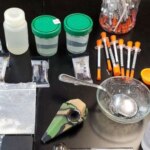This appeared in a recent issue of Medscape —
Total Abstinence Not the Only Treatment Goal in SUD
Apparently, a proposed shift away from abstinence as the treatment goal “…may open opportunities for medication development that can help individuals achieve these improved outcomes, even if complete abstinence is not immediately achievable or wanted.”
Granted, that’s a big audience for Big Pharma: people addicted to drugs or alcohol who don’t want to stop using drugs or alcohol. In my experience, almost everyone who develops an addiction of any severity will spend months or years or even decades trying to come up with a solution other than the obvious one — to stop using the substances on a more or less permanent basis.
Why so much resistance to the idea of abstinence? The reasons vary.
- Addiction, after all, is stigmatized. People would rather not acknowledge it, if avoidable. Men may view addiction as a weakness, a failing of willpower. Women may view it as deeply shameful, a sign of poor character.
- Then again, the addicted person’s own experience may lead them to believe that a return to controlled, non-problem use is possible. “I did coke daily for ten whole years and never missed a day of work,” insisted one filmmaker. “And then something changed. That had to be stress. So I’m leaving my job. That should take care of 90% of the problem.” Unfortunately, it did not.
- Or: “I’ve given up drugs before, a week or month at a time, just to prove I could. If I had truly been addicted, no way I could do that.” Wish that were the case, but it isn’t. Plenty of examples where addicted people have a long history of stopping and starting again.
And so on and so forth. It’s a reflection of the ambivalence with which the individual in treatment so often approaches the central dilemma of recovery. Few behavior patterns are more characteristic of addiction than the relentless, often futile search for a return of control over alcohol or drug use. As one former patient described it: “I was hoping to turn back the clock on my cocaine use. Get things back to the way they were, five or better yet, ten years ago.”
Anyway, the article goes on to describe the results of 13 randomized trials involving a few thousand patients seeking treatment for stimulant disorders. The result: “Most participants had no change in the level of use or increased their use through the trial (68%) or transitioned from low (1-4 days a month) to high (5 or more days a month) frequency use.”
I read that as approximately seven in 10 subjects experienced no benefit, or actually got worse. Those would be the folks who didn’t respond to treatment, and dropped out, or completed a treatment episode, then resumed their drug use — only to discover it was still a problem.
On the other end of the scale, the author reports that “Nearly one third of participants (32%) stopped or reduced drug use, including 18% who cut down on stimulant use and 14% who abstained altogether.”
“Those who reached abstinence,” they note, “showed better clinical improvement than those who reduced use on most clinical measures.”
“Well, duh,” remarked one counselor on hearing this. “I guess that confirms that no meth is still better for you than just trying to use less meth.”
Of course, scientists have been looking to invent a ‘methadone for stimulants’ since before the cocaine epidemic began in the early 70’s. So far, without success.
They’re still trying. Perhaps because a successful effort would yield immense riches for its creators. It hasn’t worked so far with alcoholism, but I figure they’ll keep trying.












